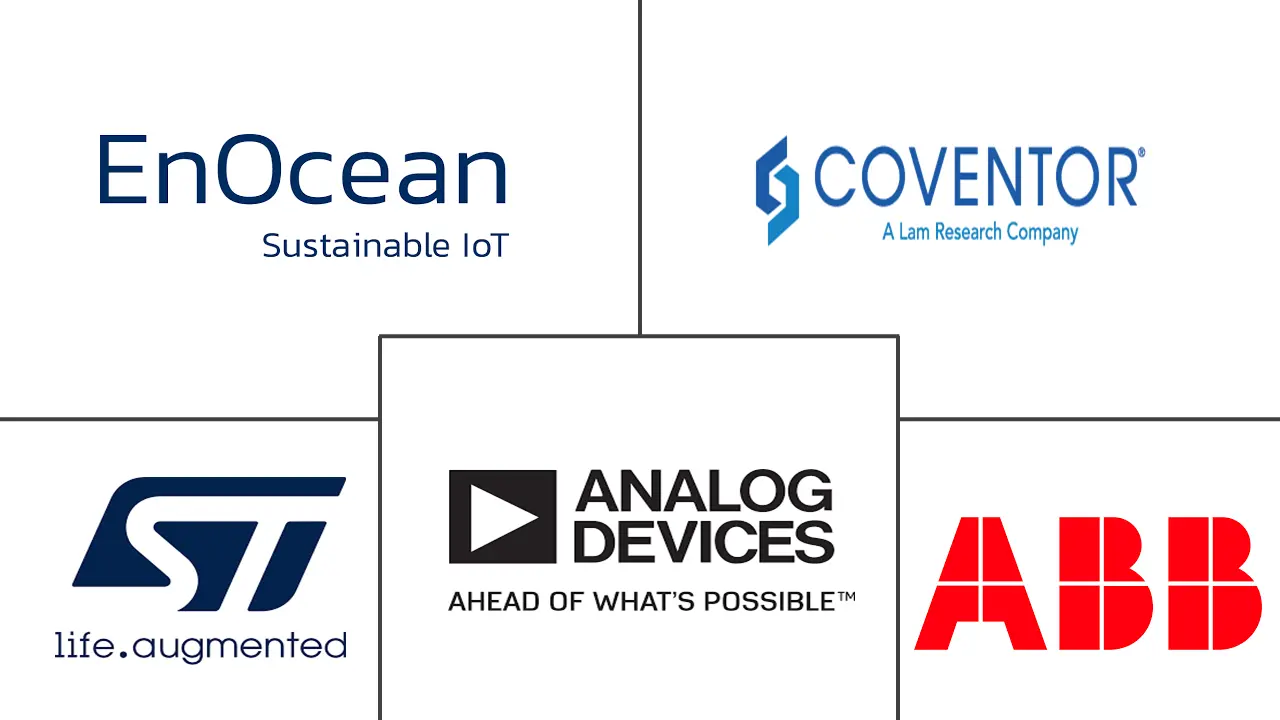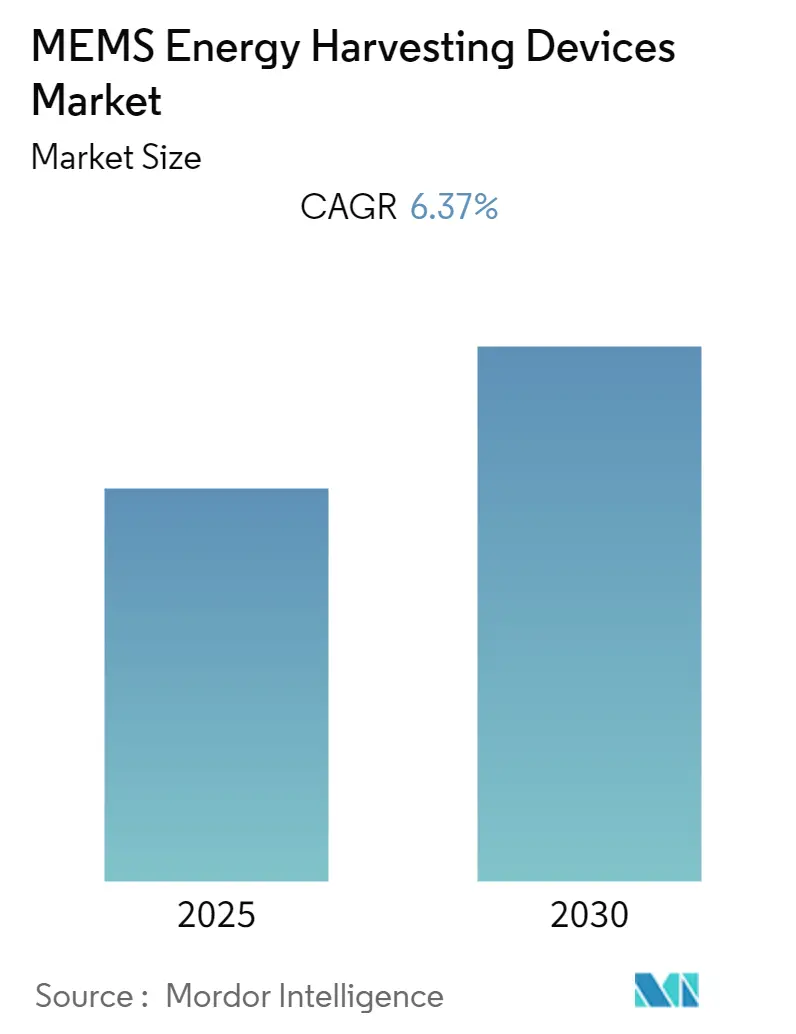
MEMS Energy Harvesting Devices Market Analysis
The MEMS Energy Harvesting Devices Market is expected to register a CAGR of 6.37% during the forecast period.
The MEMS energy harvesting devices industry is experiencing significant transformation driven by the rapid advancement of the Internet of Things (IoT) and connected devices. The proliferation of connected devices is evident with the number of connected wearable devices reaching 1,105 million units in 2022, creating substantial opportunities for energy harvesting devices solutions. This surge in IoT adoption has led to increased demand for autonomous power solutions that can operate without traditional battery dependencies. The integration of MEMS sensor technology with energy harvesting capabilities has enabled the development of more efficient and miniaturized devices that can capture energy from various environmental sources, including vibrations, thermal gradients, and electromagnetic waves.
The automotive sector has emerged as a crucial application area for MEMS energy harvesting devices, particularly with the rising adoption of electric vehicles. According to the International Energy Agency, electric cars' market share increased significantly from 4% in 2020 to 14% in 2022, indicating a growing need for advanced energy management solutions. In January 2023, WePower Technologies introduced their Gemns Energy Harvesting Generator product line, featuring three distinct products that utilize both permanent and oscillating magnets to harvest kinetic energy through electromagnetic induction. This innovation demonstrates the industry's focus on developing diverse energy scavenging devices for various applications.
Technological innovations continue to drive market evolution, with significant breakthroughs in energy conversion efficiency and device miniaturization. In February 2023, Asahi Kasei Microdevices launched a new DC-DC step-up converter specifically designed for efficient energy harvesting applications, capable of boosting low voltages for remote and battery-free operations. The development of such advanced solutions is enabling the integration of energy harvesting capabilities into increasingly compact devices while improving overall system efficiency. These technological advancements are particularly crucial for applications in wireless sensor node networks, where continuous power supply and minimal maintenance requirements are essential.
The building automation sector represents a significant opportunity for MEMS energy harvesting devices, with convenience being a primary driver of adoption. According to Hippo Holdings' recent survey, convenience accounts for 46% of smart home device utilization across all demographics, highlighting the growing demand for seamless, self-powered solutions. The integration of energy harvesting technology in building automation systems is facilitating the development of more efficient and sustainable building management solutions, reducing dependency on traditional power sources while enabling advanced monitoring and control capabilities. This trend is further supported by recent innovations, such as the development of a dynamic magnifier-enhanced piezoelectric vibration energy harvester by researchers at Osaka Metropolitan University, which can amplify power generated from impulsive vibrations by approximately 90 times while maintaining a compact form factor. Additionally, the advancements in micro power generation are paving the way for more sustainable energy solutions in building automation.
MEMS Energy Harvesting Devices Market Trends
Growth of Smart Cities
The rapid urbanization trend, with over 68% of humanity expected to live in cities by 2050, is driving the adoption of vibration energy harvesting devices as cities transform into smart urban environments. These devices are becoming crucial for powering the extensive network of sensors and IoT devices required for smart city infrastructure, particularly as Forbes reports that 70% of smart city growth potential lies in cities investing less than USD 1 million per year. This creates significant opportunities for experienced smart solution providers to integrate their knowledge and invest in projects worldwide, especially in emerging urban centers where traditional power infrastructure may be limited or costly to implement.
Smart cities utilize intelligent solutions such as the Internet of Things (IoT) and Information and Communications Technology (ICT) to maintain a balance between human quality of life and environmental preservation. Machine-to-Machine (M2M) communication, with minimal human intervention, has become increasingly prevalent, requiring sustainable power sources for applications including smart grid automation, healthcare systems, transportation networks, and environmental monitoring. The integration of piezoelectric MEMS energy harvesting devices provides a sustainable solution for powering these systems, as demonstrated by recent innovations such as Osaka Metropolitan University's development of a dynamic magnifier-enhanced piezoelectric vibration energy harvester in January 2023, which achieved a 90-times increase in power generation performance from impulsive vibration while maintaining a compact size of only 2 cm in diameter.
Commercial Applications are Slowly Getting into the Market for Industrial Applications and Home Automation Appliances
The integration of MEMS energy harvesting devices in commercial applications is gaining momentum, particularly in the industrial automation and home automation sectors, driven by the increasing emphasis on energy efficiency and smart technology adoption. According to recent industry surveys, convenience accounts for 46% of smart home device utilization across all demographics, highlighting the growing demand for seamless automation solutions. These devices are being increasingly deployed in wireless sensor networks for monitoring various parameters such as temperature, humidity, air quality, occupancy, and lighting levels, while also powering energy-efficient LED lighting systems, smart thermostats, zone-based HVAC controls, and security systems.
The industrial sector is witnessing significant transformation through the implementation of Industry 4.0 principles, where MEMS energy harvesting devices play a crucial role in powering autonomous sensors and monitoring systems. These devices are particularly valuable in industrial applications where traditional power sources are impractical or costly to maintain, such as in remote monitoring systems and large-scale manufacturing facilities. Recent technological developments, such as SiTime Corporation's introduction of a new automotive oscillator family based on advanced MEMS technology in 2023, demonstrate the expanding capabilities of these devices in ensuring reliable operation across extreme conditions. The technology's ability to provide self-sustaining power solutions while reducing maintenance costs and improving operational efficiency has made it increasingly attractive for both industrial applications and building automation systems. The use of ambient energy harvesting and mechanical energy harvesting techniques further enhances the potential for these applications, ensuring that energy is efficiently captured from the environment.
Segment Analysis: By Technology
Thermal Energy Harvesting Segment in MEMS Energy Harvesting Devices Market
Thermal Energy Harvesting continues to dominate the MEMS energy harvesting devices market, commanding approximately 46% market share in 2024. This segment's prominence is driven by its widespread utilization across major end-user industries, including consumer electronics, aerospace and defense, and automotive applications. The technology's ability to recover thermal energy from operating electronic devices such as computers, phones, automotive parts, spacecraft, and satellite components makes it particularly valuable for reducing fossil fuel dependency. The segment's success is further bolstered by its effectiveness in converting waste heat or temperature gradients into usable electrical power, making it especially suitable for powering low-power electronics such as wireless sensor nodes.
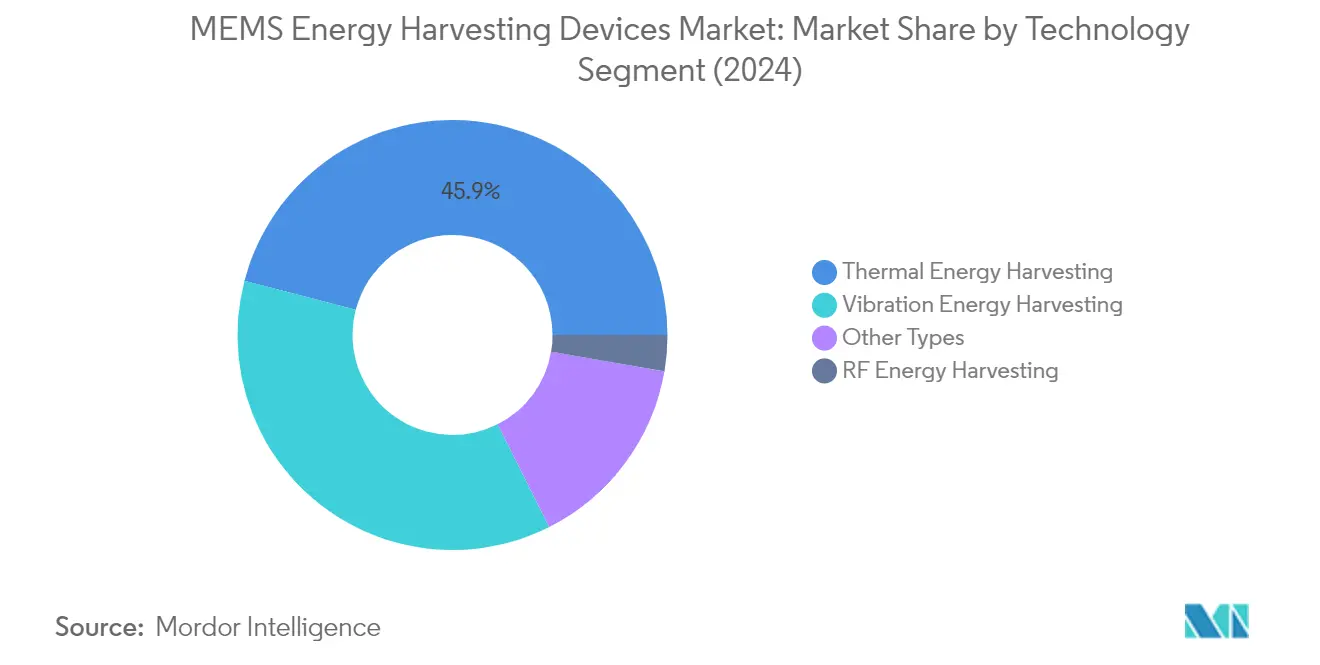
Vibration Energy Harvesting Segment in MEMS Energy Harvesting Devices Market
The Vibration Energy Harvesting segment is emerging as the most dynamic sector in the market, projected to grow at approximately 8% during 2024-2029. This growth is primarily driven by its increasing adoption in automotive applications, particularly in tire pressure monitoring systems, engine monitoring, and structural health monitoring systems. The technology's ability to convert mechanical vibrations into electrical energy through piezoelectric, electrostatic, and electromagnetic energy harvesting mechanisms makes it particularly valuable for self-powered microsystems. Recent technological advancements in piezoelectric materials and the development of more efficient energy conversion systems have further enhanced the segment's growth potential, especially in applications requiring autonomous power sources for wireless sensors and IoT devices.
Remaining Segments in MEMS Energy Harvesting Devices Market Technology
The market's remaining segments, including RF Energy Harvesting and other energy harvesting technologies, play crucial complementary roles in the overall ecosystem. RF Energy Harvesting technology is particularly significant in wireless power applications, offering solutions for IoT devices and wireless sensor networks by capturing ambient RF signals. Other energy harvesting technologies, including light and solar energy harvesting, contribute to the market's diversity by providing alternative methods for generating power in specific applications. These segments are particularly valuable in applications where thermal or kinetic energy harvesting sources may not be readily available, thus ensuring comprehensive energy harvesting solutions across different use cases and environments.
Segment Analysis: By End-User Applications
Building and Home Automation Segment in MEMS Energy Harvesting Devices Market
The Building and Home Automation segment maintains its dominant position in the MEMS energy harvesting devices market, commanding approximately 44% market share in 2024. This significant market presence is driven by the increasing emphasis on smart building technologies and the growing adoption of automated systems in residential and commercial buildings. The segment's growth is particularly fueled by the rising implementation of wireless sensor networks for monitoring various parameters such as temperature, humidity, air quality, occupancy, and lighting levels. MEMS energy harvesting devices are increasingly being integrated into smart thermostats, zone-based HVAC controls, security systems, and wireless security cameras, providing sustainable power solutions for these applications. The segment's strong performance is further supported by the growing trend of building automation, with convenience being a primary driver as highlighted by recent industry surveys indicating that convenience accounts for nearly half of smart home device utilization across all demographics.
Military and Aerospace Segment in MEMS Energy Harvesting Devices Market
The Military and Aerospace segment is emerging as the fastest-growing segment in the MEMS energy harvesting devices market, with an expected growth rate of approximately 10% during 2024-2029. This remarkable growth is driven by the increasing adoption of energy harvesting technologies in various military and aerospace applications, including soldier systems, unmanned systems, remote monitoring and surveillance, and spacecraft systems. The segment's expansion is particularly notable in applications requiring self-sustaining power solutions for remote or inaccessible locations where traditional power sources may be impractical. The growth is further accelerated by the increasing focus on developing miniaturized and integrated MEMS energy harvesting devices for smaller, compact military and aerospace systems, enabling greater flexibility and portability. The segment is witnessing significant technological advancements in areas such as structural health monitoring, environmental monitoring, and power management systems, contributing to its rapid growth trajectory.
Remaining Segments in End-User Applications
The other significant segments in the MEMS energy harvesting devices market include Automotive, Industrial, and Consumer Electronics, each contributing uniquely to the market's dynamics. The Automotive segment is gaining traction through applications in tire pressure monitoring systems, engine monitoring, and keyless entry systems. The Industrial segment is making substantial progress in manufacturing, process automation, and logistics applications, particularly in implementing Industry 4.0 initiatives. The Consumer Electronics segment is expanding through applications in smartphones, wearables, and IoT devices, focusing on creating self-sustainable power solutions for portable electronics. These segments collectively demonstrate the versatility and widespread adoption of MEMS energy harvesting technologies across various industries, each addressing specific energy harvesting needs and contributing to the overall market growth.
MEMS Energy Harvesting Devices Market Geography Segment Analysis
MEMS Energy Harvesting Devices Market in North America
The North American MEMS energy harvesting devices market holds approximately 30% market share in 2024, establishing itself as a crucial region in the global landscape. The region's dominance is primarily driven by its advanced technological infrastructure and strong presence in IoT development. North America's market is characterized by substantial investments in research and development, particularly in areas like wireless sensor networks and autonomous systems. The United States leads the regional market with its robust semiconductor industry and increasing adoption of energy harvesting device solutions in the automotive and consumer electronics sectors. The region's focus on sustainable energy solutions and the growing implementation of smart city initiatives have created favorable conditions for the MEMS energy harvesting devices market. Additionally, the presence of major technology companies and research institutions continues to drive innovation in this space. The market is further strengthened by increasing applications in building automation, industrial monitoring, and healthcare sectors, where the demand for self-powered sensors and devices continues to grow.
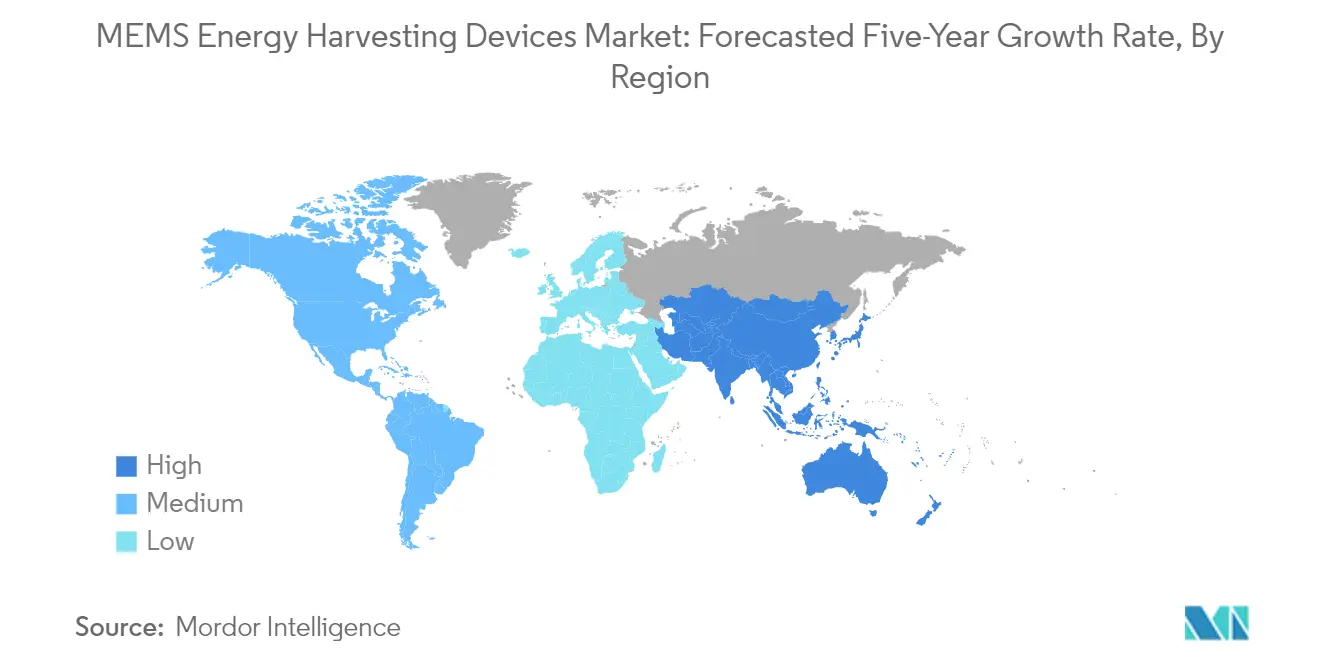
MEMS Energy Harvesting Devices Market in Europe
Europe has demonstrated consistent growth in the MEMS energy harvesting devices market, with an approximate growth rate of 5% from 2019 to 2024, reflecting the region's strong commitment to sustainable technology adoption. The European market is characterized by its robust regulatory framework supporting energy-efficient technologies and environmental sustainability initiatives. The region's market dynamics are shaped by strong industrial automation sectors in countries like Germany and France, where MEMS energy harvesting devices find extensive applications. European manufacturers have established themselves as leaders in developing innovative energy harvesting solutions, particularly in automotive and industrial applications. The region's emphasis on green technology and renewable energy sources has created a favorable environment for market expansion. Furthermore, the strong presence of automotive and aerospace industries has driven the adoption of these devices for various sensing and monitoring applications. The market also benefits from extensive collaboration between academic institutions and industry players, fostering continuous innovation and technological advancement.
MEMS Energy Harvesting Devices Market in Asia-Pacific
The Asia-Pacific MEMS energy harvesting devices market is positioned for robust expansion, with a projected growth rate of approximately 8% from 2024 to 2029. The region's market is driven by rapid industrialization and increasing adoption of IoT technologies across various sectors. Countries like China, Japan, and South Korea are at the forefront of technological innovation, particularly in consumer electronics and automotive applications. The region's manufacturing capabilities and cost-effective production environments have attracted significant investments in MEMS technology development. The market is characterized by strong government support for clean energy initiatives and smart city projects, which create substantial opportunities for MEMS energy harvesting devices applications. The growing focus on industrial automation and smart manufacturing has further accelerated market growth. Additionally, the increasing adoption of wireless sensor networks in various applications, from environmental monitoring to industrial control systems, continues to drive market expansion in the region.
MEMS Energy Harvesting Devices Market in Rest of the World
The Rest of the World region, encompassing the Middle East, Africa, and Latin America, represents an emerging market for MEMS energy harvesting devices with significant growth potential. These regions are experiencing increasing adoption of IoT and smart technologies, particularly in urban development and industrial applications. The market is driven by growing investments in infrastructure modernization and the need for sustainable energy solutions in remote locations. Countries in the Middle East are particularly focused on smart city initiatives and industrial automation, creating opportunities for MEMS energy harvesting devices applications. Latin American countries are showing growing interest in these technologies for agricultural and environmental monitoring applications. The market is characterized by increasing awareness of energy-efficient solutions and the need for autonomous power sources in regions with limited power infrastructure. Furthermore, the oil and gas industry in these regions presents significant opportunities for implementing MEMS energy harvesting devices in monitoring and control applications.
MEMS Energy Harvesting Devices Industry Overview
Top Companies in MEMS Energy Harvesting Devices Market
The MEMS energy harvesting devices market features prominent players like EnOcean GmbH, STMicroelectronics, Coventor (Lam Research), Analog Devices, ABB, Cymbet Corp, and Micropelt, leading innovation and development. Companies are focusing on advancing their R&D capabilities to develop next-generation energy harvesting devices, particularly in areas like thermoelectric, vibration, and RF energy harvesting technologies. Strategic partnerships with semiconductor manufacturers, research institutes, and end-users have become crucial for product development and market expansion. Operational agility is demonstrated through the integration of manufacturing processes with design capabilities, while companies are increasingly investing in automation and Industry 4.0 technologies to enhance production efficiency. Market leaders are expanding their geographical presence through distribution networks and strategic alliances, particularly in emerging markets where demand for energy-efficient solutions is growing.
Consolidated Market with Strong Technology Focus
The MEMS energy harvesting devices market exhibits a moderately consolidated structure dominated by global technology conglomerates and specialized manufacturers. Large-scale vendors like STMicroelectronics and ABB leverage their extensive R&D capabilities, established distribution networks, and strong financial resources to maintain market leadership. These companies typically engage in backward and forward integration, commanding significant revenue generation capabilities while offering comprehensive solutions across the value chain. The market also features specialized players like EnOcean and Cymbet, who focus on niche applications and innovative solutions in specific energy harvesting segments.
The industry has witnessed strategic mergers and acquisitions aimed at technology acquisition and market expansion, exemplified by Lam Research's acquisition of Coventor. Companies are increasingly forming partnerships with research institutions and universities to enhance their technological capabilities and develop innovative solutions. The market structure encourages collaboration between device manufacturers and end-users, particularly in industrial automation and building management applications, leading to customized solutions and long-term supply agreements. Regional players are gradually emerging, especially in Asia-Pacific, focusing on specific application areas and local market requirements.
Innovation and Customization Drive Market Success
Success in the MEMS energy harvesting devices market increasingly depends on companies' ability to develop innovative, application-specific solutions while maintaining cost competitiveness. Incumbent players must focus on continuous R&D investment, particularly in improving energy conversion efficiency and reducing form factors. Companies need to strengthen their intellectual property portfolios while developing modular product platforms that can be customized for different applications. Building strong relationships with semiconductor manufacturers and maintaining robust supply chains have become crucial for sustainable growth, especially given the industry's dependence on specialized materials and manufacturing processes.
Market contenders can gain ground by focusing on emerging applications in IoT, wearables, and smart buildings, where established players may have less presence. Success factors include developing specialized solutions for specific industry verticals, establishing strategic partnerships with system integrators, and maintaining close relationships with end-users to understand evolving requirements. Companies must also consider potential regulatory impacts, particularly regarding environmental standards and energy efficiency requirements, while addressing the challenge of end-user concentration in specific industries. The ability to offer comprehensive solutions, including software and services, alongside hardware products, will become increasingly important for market success. The rise of micro power generation technologies is also expected to play a pivotal role in shaping future market dynamics.
MEMS Energy Harvesting Devices Market Leaders
-
EnOcean Gmbh
-
STMicroelectronics NV
-
Coventor Inc. (Lam Research Corporation)
-
Analog Devices Inc
-
ABB Ltd
- *Disclaimer: Major Players sorted in no particular order
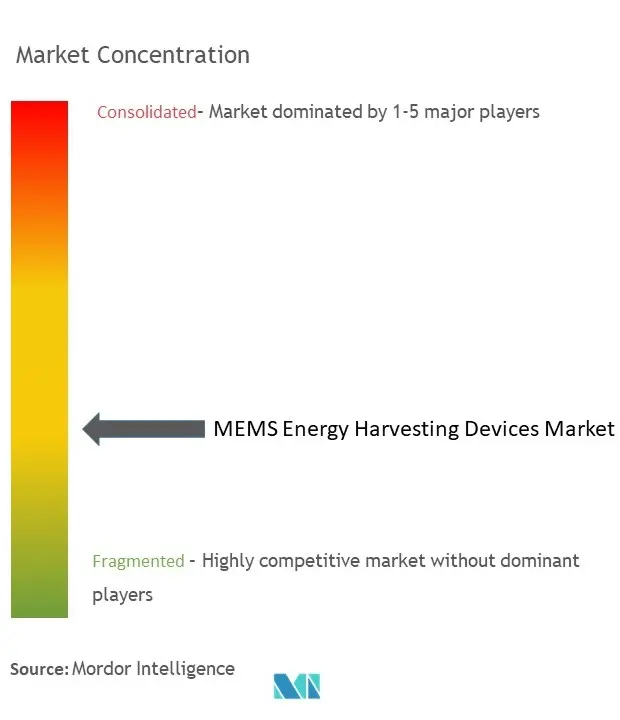
MEMS Energy Harvesting Devices Market News
- February 2023: Asahi Kasei Microdevices (AKM) launched a new DC-DC step-up converter for efficient energy harvesting applications. It can boost low voltages, offering remote and battery-free operation solutions and low-maintenance asset monitoring and IoT applications.
- January 2023: WePower Technologies, a kinetic energy harvesting startup providing scalable and sustainable power solutions for wireless IoT sensors, transmitters, and related devices, unveiled their Gemns Energy Harvesting Generator (EHG) product line. The Gemns product line includes three different products. Each uses permanent and oscillating magnets to harvest kinetic energy through electromagnetic induction: the Gemns G100 Integrated RF Switch, the Gemns G200 EHG, and the Gemns G300 EHG.
MEMS Energy Harvesting Devices Market Report - Table of Contents
1. INTRODUCTION
- 1.1 Study Assumptions and Market Definition
- 1.2 Scope of the Study
2. RESEARCH METHODOLOGY
3. EXECUTIVE SUMMARY
4. MARKET INSIGHTS
- 4.1 Market Overview
-
4.2 Industry Attractiveness - Porter's Five Forces Analysis
- 4.2.1 Bargaining Power of Suppliers
- 4.2.2 Bargaining Power of Buyers
- 4.2.3 Threat of New Entrants
- 4.2.4 Threat of Substitute Products
- 4.2.5 Intensity of Competitive Rivalry
- 4.3 Industry Value Chain Analysis
- 4.4 Impact of COVID-19 on the Market
5. MARKET DYNAMICS
-
5.1 Market Drivers
- 5.1.1 Growth of Smart Cities
- 5.1.2 Commercial Applications are Slowly Getting into the Market for Industrial Applications and Home Automation Appliances
-
5.2 Market Restraints
- 5.2.1 Ultra Low Power Electronics
- 5.2.2 Wireless Data Transmissions Rates and Standards
6. MARKET SEGMENTATION
-
6.1 By Technology
- 6.1.1 Vibration Energy Harvesting
- 6.1.2 Thermal Energy Harvesting
- 6.1.3 RF Energy Harvesting
- 6.1.4 Other Types of Energy Harvesting
-
6.2 By End-user Applications
- 6.2.1 Automotive
- 6.2.2 Industrial
- 6.2.3 Military and Aerospace
- 6.2.4 Building and Home Automation
- 6.2.5 Consumer Electronics
- 6.2.6 Other End-user Applications
-
6.3 By Geography
- 6.3.1 North America
- 6.3.2 Europe
- 6.3.3 Asia-Pacific
- 6.3.4 Rest of the World
7. COMPETITIVE LANDSCAPE
-
7.1 Company Profiles
- 7.1.1 EnOcean Gmbh
- 7.1.2 STMicroelectronics NV
- 7.1.3 Coventor Inc. (Lam Research Corporation)
- 7.1.4 Analog Devices Inc
- 7.1.5 ABB Ltd
- 7.1.6 Cymbet Corp
- 7.1.7 Micropelt (EH4 GmbH)
- *List Not Exhaustive
8. INVESTMENT ANALYSIS
9. MARKET OPPORTUNITIES AND FUTURE TRENDS
MEMS Energy Harvesting Devices Industry Segmentation
MEMS energy harvesting devices capture and accumulate byproduct energy as it becomes available and then store it for some time. These devices then supply it in a form that can be used later, such as operating a microprocessor within its limits. It supports energy harvesting systems that can also be used in low-voltage and low-power applications, such as portable or mobile devices, automotive, medical, industrial machine monitoring and process control, home automation, and defense.
The MEMS energy harvesting devices market is segmented by technology (vibration energy harvesting, thermal energy harvesting, RF energy harvesting, and other types of energy harvesting), end-user applications (automotive, industrial, military and aerospace, building and home automation, consumer electronics, and other end-user applications), and geography (North America, Europe, Asia-Pacific, and rest of the world). The market sizes and forecasts are in value (USD) for all the segments.
| By Technology | Vibration Energy Harvesting |
| Thermal Energy Harvesting | |
| RF Energy Harvesting | |
| Other Types of Energy Harvesting | |
| By End-user Applications | Automotive |
| Industrial | |
| Military and Aerospace | |
| Building and Home Automation | |
| Consumer Electronics | |
| Other End-user Applications | |
| By Geography | North America |
| Europe | |
| Asia-Pacific | |
| Rest of the World |
MEMS Energy Harvesting Devices Market Research FAQs
What is the current MEMS Energy Harvesting Devices Market size?
The MEMS Energy Harvesting Devices Market is projected to register a CAGR of 6.37% during the forecast period (2025-2030)
Who are the key players in MEMS Energy Harvesting Devices Market?
EnOcean Gmbh, STMicroelectronics NV, Coventor Inc. (Lam Research Corporation), Analog Devices Inc and ABB Ltd are the major companies operating in the MEMS Energy Harvesting Devices Market.
Which is the fastest growing region in MEMS Energy Harvesting Devices Market?
Asia Pacific is estimated to grow at the highest CAGR over the forecast period (2025-2030).
Which region has the biggest share in MEMS Energy Harvesting Devices Market?
In 2025, the Europe accounts for the largest market share in MEMS Energy Harvesting Devices Market.
What years does this MEMS Energy Harvesting Devices Market cover?
The report covers the MEMS Energy Harvesting Devices Market historical market size for years: 2019, 2020, 2021, 2022, 2023 and 2024. The report also forecasts the MEMS Energy Harvesting Devices Market size for years: 2025, 2026, 2027, 2028, 2029 and 2030.
Our Best Selling Reports
MEMS Energy Harvesting Devices Market Research
Mordor Intelligence provides a comprehensive analysis of the MEMS energy harvesting devices market. We leverage our extensive expertise in MEMS sensor technology and emerging energy solutions. Our research covers various technologies, including piezoelectric MEMS, electromagnetic energy harvesting, and thermal energy harvesting systems. The report examines developments in vibration energy harvesting and mechanical energy harvesting technologies. Additionally, it explores innovations in micro power generation and energy scavenging devices. Detailed insights are available in an easy-to-download report PDF format.
Stakeholders benefit from our in-depth analysis of kinetic energy harvesting applications and wireless sensor node implementations across industries. The report explores advancements in micro energy harvesting and ambient energy harvesting technologies. It also provides a detailed evaluation of micro power systems development. Our comprehensive coverage of energy harvesting devices includes emerging applications and technological breakthroughs. This offers valuable insights for businesses involved in the MEMS sensor market and related industries, supporting informed decision-making and strategic planning initiatives.

